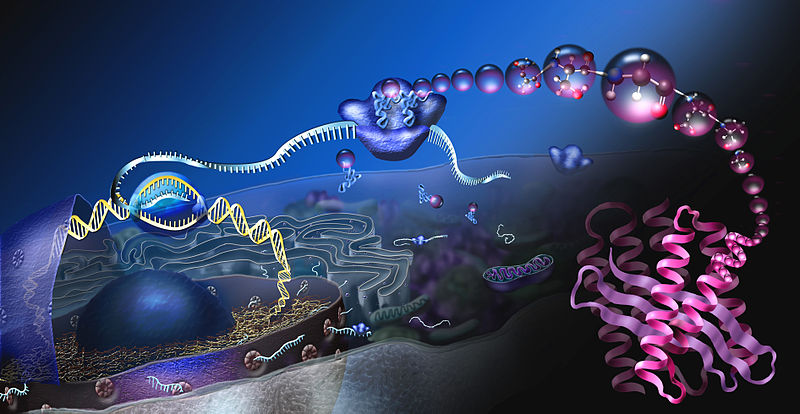
By Nicolle Rager, National Science Foundation [Public domain], via Wikimedia Commons
DNA translation is the process by which DNA instructions are turned into proteins. This process is essential to all living organisms. Much like an assembly line, DNA instructions are followed through a step-by-step process until a finished product (a protein) is produced. Proteins are responsible for things like organ and tissue function, signal transmission between cells, and chemical reactions in the body. One mistake in the instructions could either have no effect, or disastrous effects. So how does this wondrous process of DNA translating take place?
It all starts with a process called transcription, in which the DNA code is literally transcribed (copied). First, a gene is “unzipped” and one of the strands of the DNA code is copied into what is called mRNA. Once a section has been copied it moves through the cell to a structure called a “ribosome” that “reads” the code. The code is a language that tells the ribosome what kind of protein subunits (molecules known as amino acids) to assemble and in what order.
Once the proteins are produced, they can get to work carrying out one of thousands of different functions. Genes that code for hormones regulate body functions and brain activity. Genes that code for immune function produce T-cells that defend the body against infection. Without the DNA code, our body would not be able to function and we would cease to exist.
As a trained biologist, I marvel at the complexity and simplicity of all biological systems. It stuns me whenever I think that functions as big as heart rate and breathing must ultimately rely on a system so small. As a pastor, I let my wonder lead me to worship. I also call others to praise God for biological systems that are marvelous to behold.
Science can take us beyond knowing what DNA is and how it works, and is now offering us a way of accurately editing the code. In a lab environment, this is an incredible tool for understanding how living cells work. The new technique is called CRISPR (pronounced crisper). Scientists introduce a DNA cutting protein called CAS9 which contains a strand of RNA that matches a specific gene. Once the CAS9-RNA complex finds its target location, it unwinds the DNA, matches, binds, and cuts it. The cell will naturally try to repair the cut, which often leads to a mutation at that site. These mutations essentially “knock out” or switch off the gene.[1]
In previous gene editing experiments that used different techniques the success rates were between 50-70%. These techniques involved introducing DNA into the nucleus of the cell with the hope that the cell would integrate it without any overly negative side effects.[2] However, in a recent study with the very precise CRISPR CAS9 system, the success rate was an astounding 95%.[3] This is truly a rare and remarkable development.
Francis Collins, the Director of the National Institutes for Health, wrote in his book, The Language of God, “The God of the Bible is also the God of the genome. He can be worshipped in the cathedral or in the laboratory. His creation is majestic, awesome, intricate, and beautiful.” As Christians, when we look at the workings of the human genome, we see how majestic, awesome, intricate, and beautiful it is, and are inspired to worship God. The study of nature can drive us toward a deeper and more meaningful relationship with God.
However, modifying our genome through CRISPR technology raises all sorts of biological, ethical, and social questions. We can feel our sense of wonder being translated into curiosity and/or concern. What might happen if this kind of technology were to be implemented all over the world? What good might be accomplished in people’s lives? What harm might come of it? My prayer is that scientists and theologians would consider questions like these.
It is up to us to wonder about the questions that come from editing DNA. All the while, let wonder at the marvel of DNA translate into worship.
[1] Luisa Bortesi and Rainer Fischer. “The CRISPR/Cas9 system for plant genome editing and beyond.” Biotechnology advances 33, no. 1 (2015): 41-52.
[2] National Research Council, et al. Safety of genetically engineered foods: Approaches to assessing unintended health effects, (National Academies Press, 2004), 29.
[3] Heidi Ledford, “CRISPR fixes disease gene in viable human embryos,” Nature 548, no. 7665 (August 2017): accessed August 04, 2017, http://www.nature.com/news/crispr-fixes-disease-gene-in-viable-human-embryos-1.22382#/b1.
 Mario Anthony Russo is a pastor, writer, and urban church planter. He earned a Bachelor of Science degree in Biology and Psychology from the University of South Carolina, a Master of Arts in Religion from Reformed Theological Seminary, and a Doctor of Ministry from Erskine College and Seminary. His interests include the interaction between science and faith, missiology, and pastoring. He and his wife Virginia along with their two children live and work in the Rhine-Ruhr region of Germany.
Mario Anthony Russo is a pastor, writer, and urban church planter. He earned a Bachelor of Science degree in Biology and Psychology from the University of South Carolina, a Master of Arts in Religion from Reformed Theological Seminary, and a Doctor of Ministry from Erskine College and Seminary. His interests include the interaction between science and faith, missiology, and pastoring. He and his wife Virginia along with their two children live and work in the Rhine-Ruhr region of Germany.



